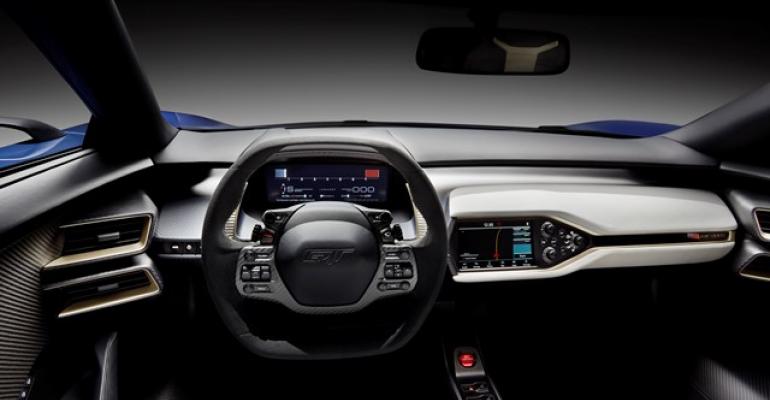DEARBORN, MI – The science behind designing a great vehicle interior takes a leap forward as Ford discusses recent biometric research intended to better understand consumer preferences behind the wheel.
As the automaker prepares to launch the Ford GT supercar next year, executives say the vehicle program gets a boost from a new research project that quantifies a driver’s emotional attachment to a vehicle interior and even tracks brainwaves and eye movements.
“We’re trying to measure the way customers react to our interiors,” says Raj Nair, Ford group vice president-global product development. “The data we collect… will help the design team and the engineering team shape the best user experience and make more informed design decisions.”
The automaker wants to better understand how people explore their interiors, react to what they find and then identify likes and dislikes. “Then we can lay out the functions in the most efficient manner.”
Most of the study has been centered in the U.S. and China and has involved hundreds of drivers, says Moray Callum, vice president-design. He says the so far unnamed project remains under development, and it will be a while before the methodology yields widespread results in Ford interiors.
As part of the eye-tracking study, Ford researchers found drivers getting behind the wheel look first at the instrument cluster, then down at the steering wheel, then up at the base of the windshield, then down to the central display screen, center stack controls and shifter before looking left toward the side-view mirror then across to the passenger side.
The study also finds 80% of participating drivers spend significant time looking at the instrument cluster – far and away more than any other aspect of the interior, Nair says. Some 55% of participating drivers look often at the central display screen, generally positioned in the upper part of the instrument panel.
This pattern of eye movement seems to be consistent whether the driver is getting into an F-150 pickup or a Focus compact car, Callum says.
Eye-tracking is vital because it confirms what part of the interior gets noticed first, which plays a big part in a vehicle’s overall first impression, Nair says. “It helps us prioritize how we want to delight the customer,” he says.
Likewise, it shows which parts of the interior are being ignored. “We can make some areas more interesting to the senses,” he says.
Biometrics ties into the research, as well, to identify areas in the interior that elicit a higher or lower emotional response.
“What’s grabbing people’s attention? What’s making them engage or disengage?” Nair says. Drivers participating in the study are hooked up to monitors for measuring brain activity and vital signs.
“We are doing all this research way up front even before we get an evaluation of colors or materials or perception of quality or other critical elements we will continue to use – customer clinics and other methods to evaluate,” Nair says.
Biometrics Applied to GT Interior
The research has yielded “building blocks” on which the Ford GT interior was designed. Consumer clinics were not conducted while shaping the GT cabin, Nair says.
The star of the 2015 North American International Auto Show, kept secret until its unveiling in January, places a premium on interior space, with room for only two occupants under a low canopy required for optimal aerodynamics.
“The low roof height also demanded we go with a fixed seating position for some of our crash requirements,” Nair says. The seats are integrated into the carbon-fiber tub, and the pedals and steering wheel are adjusted to accommodate the driver’s size.
The human-machine interface required much attention as controls had to be within easy reach of a fully belted driver, even in a racing harness.
The interior needed to convey a connection to motorsports. Aluminum paddle shifters were machined smooth, and rotary knobs for climate control are made of anodized aluminum.
“There’s a performance driving design theme, and it demands real focus on function,” Nair says. As a result, the instrument panel has singular buttons for key functions that are strategically placed to avoid inadvertent actuation.
“How does the customer connect with the car?” Callum asks. “It’s really important that the technology is intuitive, that the customer knows how to use it.”
The sleek, horizontally arrayed 2-tier instrument panel is designed to convey lightness.
Likewise, seats are made as thin as possible, with padding placed only where needed. Hard parts in the interior are one color, while soft parts are another, Callum notes.
Parts of Ford’s research project will be used in different vehicles going forward. “But we’re not saying we will use it on every car,” he says.
The average American commutes 25.4 minutes to work each day, according to government figures. “On average, we spend at least 50 minutes a day, four hours a week – that’s 10 full days in our car every year,” Nair says. “We really mean it when we say we live in our interiors. It’s a very personal space.”
An interior that is not well thought out “can quickly translate into a loss of satisfaction,” he says, noting the massive improvements of vehicle interiors in recent years.
“It’s fair to say a base entry model today is on par or even better than the highest possible trim level from just a decade ago,” Nair says.
Callum also says Ford’s latest research confirms a truth about American drivers: They love their cupholders.





